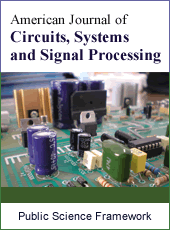American Journal of Circuits, Systems and Signal Processing
Articles Information
American Journal of Circuits, Systems and Signal Processing, Vol.5, No.1, Mar. 2019, Pub. Date: Jan. 27, 2019
Application of Linear Differential Equation in an Analysis Transient and Steady Response for Second Order RLC Closed Series Circuit
Pages: 1-8 Views: 2965 Downloads: 3576
[01]
Ahammodullah Hasan, Department of Mathematics, Faculty of Applied Science and Technology, Islamic University, Kushtia, Bangladesh.
[02]
Md. Abdul Halim, Department of Electrical and Electronic engineering, World University of Bangladesh, Dhaka, Bangladesh.
[03]
Md. Al-Amin Meia, Department of Mathematics, Govt. Adamjeenagar Merchant Worker (M. W) College, Narayanganj, Bangladesh.
In this Paper, this work investigates the application of RLC diagrams in the catena study of linear RLC closed series electric circuits. The Relevant second order ordinary differential equations were solved by Kirchhoff’s Voltage law. This solution obtained was employed to procedure RLC diagram simulated by MATLAB and Mathematica 9.0. A circuit containing an inductance L or capacitor C and resistor R with current and voltage variable given by differential equation. The general solution of differential equation has two parts complementary function (C. F) and particular integral (P. I) in which C. F. represents transient response and P. I. represents steady response. The general solution of differential equation represents the complete response of network. In this connection, this paper includes RLC circuit and ordinary differential equation of second order and its solution.
Circuit Analysis, RLC Circuit, Ordinary Differential Equation, Transient Response, Steady Response, Kirchhoff’s Law
[01]
Ajide, O.O. 2008. Bifurcation diagrams of some selected chaotic systems.
[02]
Abilash, “Step Response Analysis on First Order RC Circuit”, American Journal of Circuit, System and Signal Processing, Vol. 3, No. 1, pp. 1-5, 2017.
[03]
R. P. Rajendra, “Application of differential equation in L-R and C-R circuit analysis by classical Method”, Janapriya Journal of interdisciplinary studies, Vol. 5, pp114-123, Dec -2016.
[04]
S. Anuj, “Transient Analysis Of Electric Circuit Using Runge-Kutta Method and its Application”, International Jounal of Science and Research Publication, Vol. 3, Issue 11, Nov. 2013.
[05]
Alexander L. Schulz. Capacitors: Theory, Types, and Applications. Nova Science Publishers, pp. 18, 2010.
[06]
Roland E. Thomas, Albert J. Rosa, Gregory J. Toussaint. The Analysis and Design of Linear Circuits, John Wiley & Sons, pp. 321-322, 2012.
[07]
Gilles Brocard. The LT Spice IV Simulator Manual, Methods and Applications, Swiridiff Verlag, pp. 316, 2013.
[08]
Jems William Nilsson, Susan Riedel Electric Circuits, Pearson, pp. 266-269, 2008.
[09]
J. D. Irwin, “Basic Engineering Circuit Analysis” 5th edition, Prentice Hall, Upper Saddle River, NJ, 1996
[10]
Sharma. D. Poudel, T. N. And Adhakari, H. P. (2067). Engineering Mathematics II. Katmandu: Sukanda Pustak Prakashan.
[11]
Gupta. S, “A course in Electrical circuit Analysis”, New Delhi: Dhanpat rai Publication Private Limited, 2000.
[12]
B. Rani and D. P. Choudhury, “ Elementary Ordinary Differential Equations”, Alpha Science International Ltd, oxford, Uk, 2005.
[13]
Advanced Engineering Mathematics, Wiley and Sons Publications by Erwin Kreyszig Part An Ordinary Differential Equations.
[14]
Mahmood Nahvi, Joseph A. Edminister. Schaum's Outline of Electric Circuits. McGraw-Hill, pp. 318, 2014.
[15]
Cletus J. Kaiser. The Capacitor Handbook A Comprehensive Guide For Correct Component Selection In All Circuit Applications. C J Publishing, 2 edition, pp. 77, 2011.
[16]
Numerical Analysis of ordinary differential equations: Runge-Kutta method and general linear methods,-J. C. Butcher, University of Auckland.
[17]
Comparing Numerical Methods for Ordinary Differential Equations-T. E. Hull, W. H. Enright and A. E. Sedgwick (08th September 1971).
[18]
K. S. Suresh Kumar. Electric Circuits and Networks, Pearson, pp. 420-421, 2008.
[19]
Gilles Brocard. The LTSpice IV Simulator Manual, Methods and Applications, Swiridoff Verlag, pp. 316, 2013.
[20]
Francois E. Cellier, Ernesto Kofman., “Continuous System Simulation”, Springer, pp. 11-12, 2006.
[21]
Oktay Alkin, Signals and Systems, CRC press, pp. 148-150, 2014.

ISSN Print: 2381-7194
ISSN Online: 2381-7208
Current Issue:
Vol. 6, Issue 1, March Submit a Manuscript Join Editorial Board Join Reviewer Team
ISSN Online: 2381-7208
Current Issue:
Vol. 6, Issue 1, March Submit a Manuscript Join Editorial Board Join Reviewer Team
| About This Journal |
| All Issues |
| Open Access |
| Indexing |
| Payment Information |
| Author Guidelines |
| Review Process |
| Publication Ethics |
| Editorial Board |
| Peer Reviewers |


